17 Best Astronomy and Telescope Books for Beginners
“A Universe from Nothing” by Lawrence Krauss presents the argument that the universe emerged from a quantum vacuum, a state of “nothing” filled with virtual particles and antiparticles constantly appearing and disappearing. Krauss asserts that the laws of physics can explain the origins of the universe without the need for a divine creator. In “Packing for Mars,” Mary Roach explores the realities of living in space, focusing on the unglamorous aspects of space missions, such as dealing with bodily functions in zero gravity and the psychological issues of confinement in a small spacecraft.
“Astrophysics for People in a Hurry” by Neil deGrasse Tyson serves as an introduction to major concepts in astrophysics, covering topics such as the origins of the universe, galaxies, stars, and the search for life beyond Earth. “A Briefer History of Time,” co-authored by Leonard Mlodinow and Stephen Hawking, aims to explain complex scientific concepts to a general audience, including the origins of the universe, black holes, and the ongoing efforts to develop a unified theory.
“Cosmos” by Carl Sagan is a renowned book and TV series that explores the vast expanse of the universe and the rich history of science. Sagan takes the reader on an immersive journey through the cosmos, delving into major discoveries and introducing figures that have shaped our modern scientific understanding. “NightWatch: A Practical Guide to Viewing the Universe” by Terence Dickinson is a comprehensive guide to viewing and understanding the night sky across all seasons, providing detailed star charts, instructions for backyard stargazing, and information on telescopes and other equipment.
1. Universe From Nothing by Lawrence Krauss
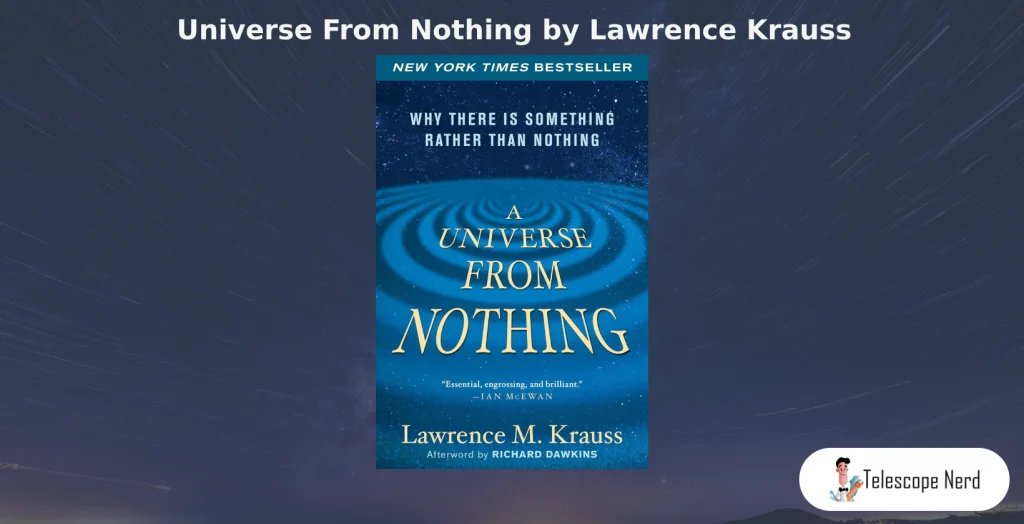
Lawrence Krauss presents an argument that the universe could have emerged from a quantum vacuum in book “A Universe from Nothing.” Quantum vacuum is a state of “nothing” that is not a complete absence of existence. “Nothing” is a seething sea of virtual particles and antiparticles, constantly popping in and out of existence. This concept forms the foundation of Krauss’s explanation for the origin of the universe.
Krauss’s argument is rooted in the scientific understanding of the quantum vacuum,. It is filled with fluctuations where particles and antiparticles constantly appear and annihilate each other. This idea is supported by research in quantum mechanics, general relativity, astronomy, and particle physics. Krauss asserts that the laws of physics, including quantum mechanics and general relativity, can explain the origins of the universe without the need for a divine creator or any external influence.
The total energy of the universe is another crucial aspect of Krauss’s argument. He posits that the total energy of the universe is zero, with the positive energy of matter balanced by the negative energy of gravity. The energy required to create the universe is borrowed from the quantum vacuum and then returned, maintaining the total energy at zero. This idea is supported by the concept of negative energy density, a well-established concept in cosmology.
Concept of virtual particles plays a significant role in Krauss’s argument. These particles and antiparticles constantly appear and annihilate each other in the quantum vacuum. Matter can emerge from this “nothingness” through a process known as pair production. This process, governed by the laws of quantum mechanics, allows for the creation of matter and energy from the quantum vacuum.
Krauss’s argument is a scientific explanation for the origins of the universe, not a philosophical or theological treatise. It challenges traditional notions of creationism and supports the principles of atheism. Krauss’s argument is rooted in scientific evidence and theories, not philosophical or theological beliefs. His book aims to provide a scientific explanation for the origins of the universe, making complex cosmological concepts accessible and thought-provoking.
2. Packing for Mars by Mary Roach
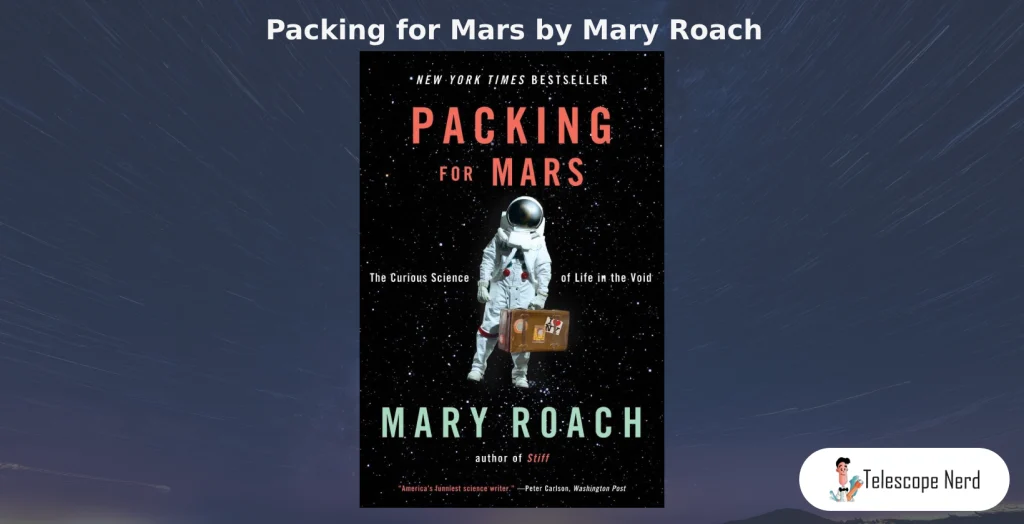
“Packing for Mars” by Mary Roach is one of the best books related to space exploration, especially for beginners who are just starting to get into the intricacies of space travel. This book explores the oddities and challenges that are often overlooked in other space-related books. Roach’s unique approach to the subject matter makes it an engaging and entertaining read. Packing for Mars was published in 2010.
The book examines the realities of living in space, focusing on the unglamorous aspects of space missions that astronauts have to deal with. It discusses the challenges of dealing with bodily functions in zero gravity and the psychological issues that come with confinement in a small spacecraft for extended periods. Roach’s wit and curiosity make these topics not only informative but entertaining.
Packing for Mars covers the absurd and entertaining aspects of space travel. Roach dives into topics such as space food and space toilets, providing a unique perspective on the intricacies and peculiarities of human physiology in space.
Roach’s storytelling skills make the book an illuminating and comedic look at the space program. She explores the creative solutions and compromises that have been developed for space survival. The book highlights the human factors and challenges in space exploration, making it a must-read for anyone interested in the subject.
The book is based on meticulous research, including interviews with astronauts, scientists, and engineers. This research provides a comprehensive and well-rounded look at space travel. Packing for Mars is considered one of the best books about space exploration, offering a unique, engaging, and humorous perspective on the subject.
3. Astrophysics for People in a Hurry by Neil deGrasse Tyson
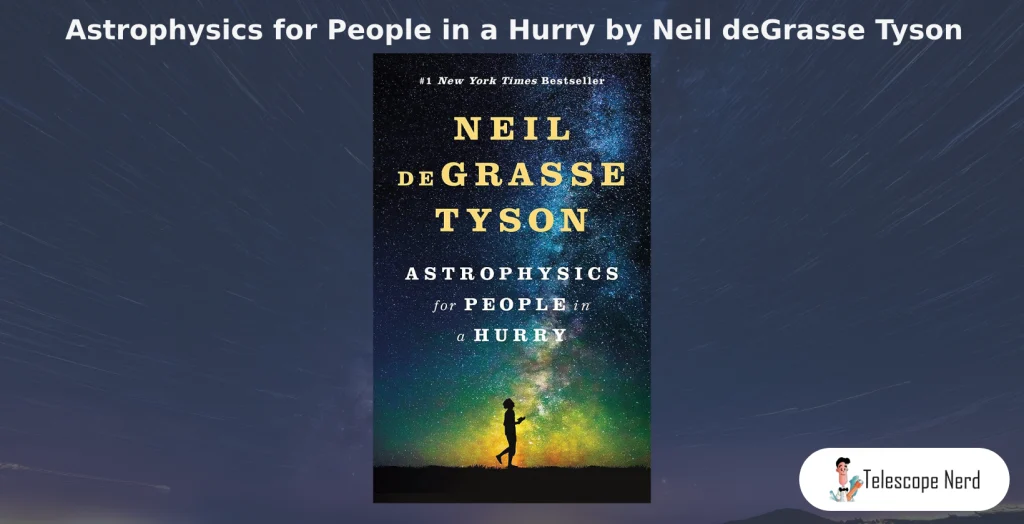
“Astrophysics for People in a Hurry” by Neil deGrasse Tyson is a book that serves as a starting point for beginners in astronomy and stargazing. This book is considered one of the best astronomy-related books for those who are just starting to explore the wonders of space. It simplifies complex concepts without using advanced mathematics or theories, making it a good choice for a beginner’s astronomy book.
Book provides an introduction to major concepts in astrophysics. It covers a wide range of topics such as the origins of the universe, galaxies, stars, planets, the Big Bang theory, dark matter, dark energy, and the search for life beyond Earth. Tyson explains these concepts clearly and uses wit, making the learning process enjoyable and engaging.
The book is concise and avoids overwhelming technical details, which is a great feature for beginners. Tyson uses relatable analogies and metaphors to make complex ideas accessible. This approach allows readers to grasp astronomical concepts more easily. The book is suitable for those with little prior knowledge of astrophysics, making it an ideal choice for beginners in astronomy and cosmology.
“Astrophysics for People in a Hurry” has become a bestseller and is highly recommended by reviewers. It is recognized as a great starting point for those interested in astronomy and space. The book is divided into 12 chapters, each tackling a distinct aspect of astrophysics. It covers basic astronomical concepts and defines key terms like “astronomical units” and “light-years.”
The book serves as a gateway to more comprehensive studies in astrophysics. It aims to inspire curiosity and wonder about the universe. While it is not a textbook, it provides more depth than a typical popular science book.
4. A Briefer History of Time by Leonard Mlodinow and Stephen Hawking
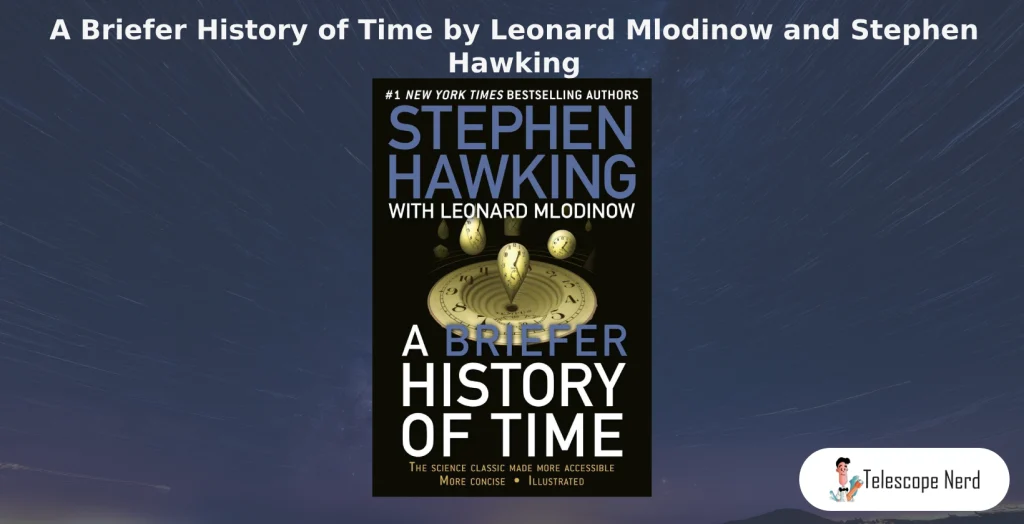
A Briefer History of Time is an updated and more accessible version of Hawking’s original book, A Brief History of Time. The primary aim of A Briefer History of Time book is to explain complex scientific concepts to a general audience in a more concise and understandable manner. A Briefer History of Time was published in 2005.
The book simplifies the explanations of various complex topics, including the origins of the universe, black holes, and the ongoing efforts to develop a unified theory. This unified theory aims to reconcile two major pillars of modern physics: quantum mechanics and general relativity, which have traditionally been at odds with each other.
A Briefer History of Time features insights from string theory, observational data from powerful telescopes like Hubble, and findings from particle physics experiments. The quest for a unified theory remains elusive, and the book guides readers through humanity’s ongoing endeavor to understand the fundamental laws governing the cosmos.
A Briefer History of Time is designed to be more concise and comprehensible for readers without a strong scientific background. Mlodinow and Hawking employ the use of analogies, examples, illustrations, and diagrams to explain complex concepts, making it easier for non-experts to grasp.
The content coverage of A Briefer History of Time is extensive. It explores the Big Bang theory, the expansion of the universe, the enigmatic concepts of dark matter and dark energy, the no-boundary proposal, and the idea of eternal inflation. Authors discuss the behavior of matter and energy under extreme conditions and the role of gravity in shaping the universe.
A Briefer History of Time serves as an updated entry point into the realms of cosmology, relativity, and quantum theory, offering an engaging exploration of these fascinating subjects by one of the greatest scientific minds of our time.
5. Cosmos by Carl Sagan
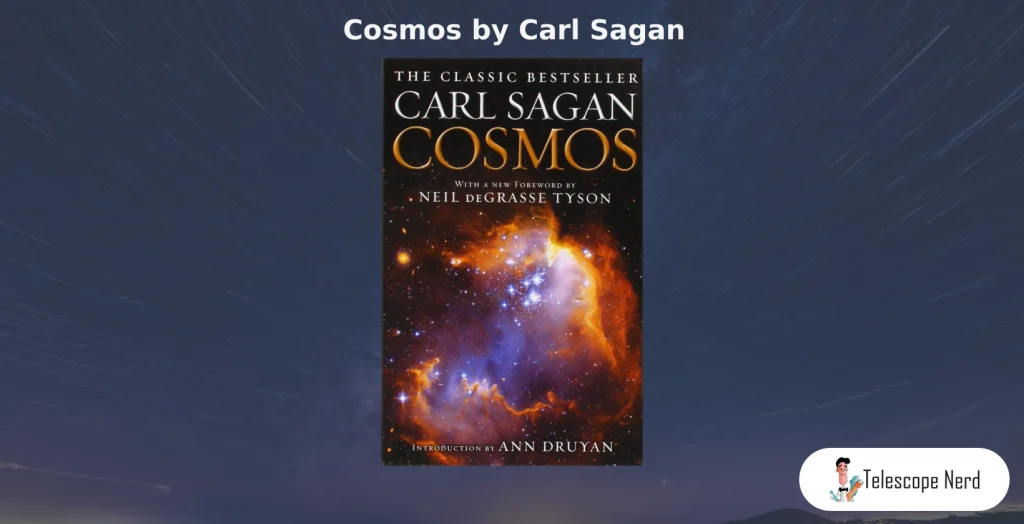
Cosmos by Carl Sagan is a renowned book and TV series that has left an indelible mark on the world of astronomy and science communication. Carl Sagan created Cosmos with the intention of exploring the vast expanse of the universe and the rich history of science. The book and TV series are both accessible and comprehensive, covering a wide array of topics including astronomy, astrophysics, cosmology, planetary science, and the origins of life on Earth.
Sagan takes the reader on an immersive journey through the cosmos, delving into major discoveries and introducing figures that have shaped our modern scientific understanding. Among these influential figures are Galileo, Kepler, and Newton. Sagan’s ability to explain complex concepts such as the Big Bang theory, the nature of stars and galaxies, and the search for extraterrestrial life in an engaging and poetic manner is one of the key reasons for the enduring popularity of Cosmos.
One of the primary aims of Cosmos was to rekindle public interest in the cosmos and the spirit of scientific exploration and discovery. Sagan’s gift for making complex ideas understandable, coupled with his emphasis on the human dimension of cosmic discoveries, resonated with a wide audience. By emphasizing the importance of maintaining a cosmic perspective about our small place in the vastness of space, Sagan brought astronomy and science to the masses.
Sagan’s use of captivating storytelling and stunning visuals to convey complex scientific concepts in an accessible and engaging way is a hallmark of Cosmos. Both the 13-part television series and the accompanying book serve as comprehensive and accessible overviews of astronomy, astrophysics, and the search for life beyond Earth. The book, published in 1980, is divided into 13 chapters that correspond to the episodes of the TV series.
6. NightWatch: A Practical Guide to Viewing the Universe by Terence Dickinson
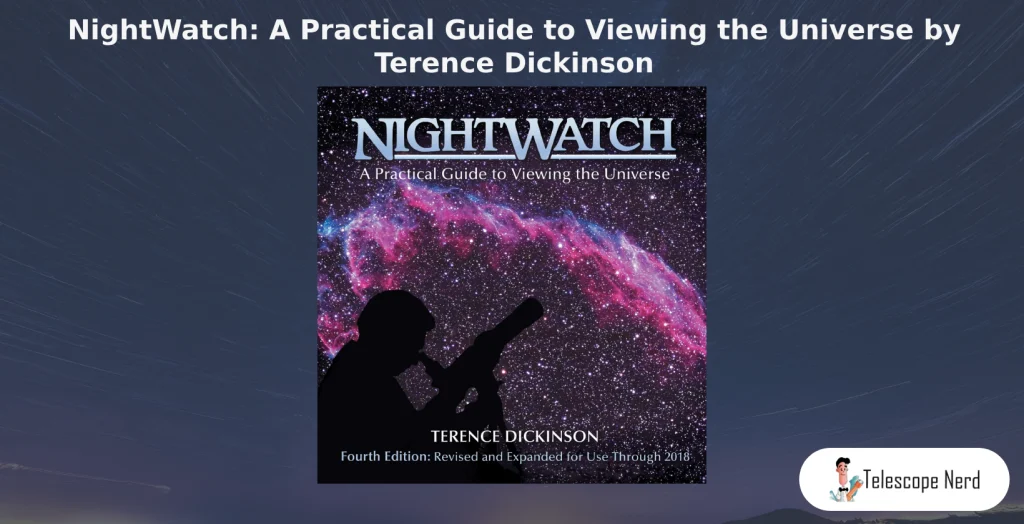
“NightWatch: A Practical Guide to Viewing the Universe” by Terence Dickinson is an exceptional astronomy book, widely recognized as one of the best resources for beginners and amateur stargazers. This comprehensive guide is designed to introduce readers to the wonders of the night sky and the vastness of space.
Terence Dickinson is a renowned Canadian science writer specializing in astronomy. Terence has written over 14 astronomy books. His work in “NightWatch” is particularly noteworthy for its practical approach to astronomy, making it an ideal choice for beginners. The book offers a general introduction to astronomy and stargazing, and is praised as a must-have handbook for amateur astronomers of all levels.
“NightWatch” provides a comprehensive guide to viewing and understanding the night sky across all seasons. It includes detailed star charts, instructions for backyard stargazing, and information on telescopes and other equipment for astronomy hobbyists. The book is beautifully illustrated and packed with information, making it an essential reference for both beginners and more experienced amateur astronomers.
NightWatch has gone through multiple revised editions over its 40+ year history. Each update ensures the latest guidance and astronomical data tables projected years in advance, keeping the book relevant and accurate.
“NightWatch” offers practical advice on getting started with stargazing. It provides tips on choosing the right equipment, including binoculars and telescopes, and instructions on how to navigate the night sky using star charts and planispheres. The book’s clear and concise writing style makes it accessible to readers with little or no prior knowledge of astronomy. It is filled with diagrams, illustrations, and photographs to help explain complex astronomical concepts.
The book covers topics such as space exploration, astronomical events, and the history of astronomy. It helps readers identify constellations, stars, and other celestial objects. “NightWatch” is consistently recommended as one of the best practical guidebooks for beginners and is considered a good starting point for developing skills in astronomy and stargazing.
7. The End of Everything by Katie Mack
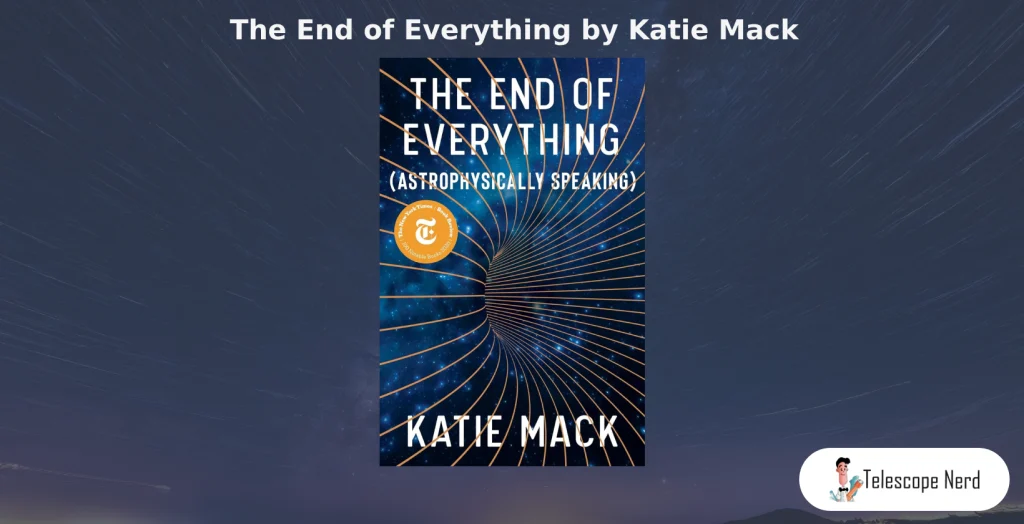
Katie Mack presents an exploration of the cosmos in her book “The End of Everything.” The End of Everything was published in 2020. This book goes into various scenarios that could potentially mark the end of the universe, drawing on scientific theories and cutting-edge research to provide an accessible and engaging tour of cosmology and physics.
Mack explores a range of concepts that describe the universe’s possible demise. These include the Big Crunch, Heat Death and the Big Rip. Mack examines the Big Freeze, a hypothesis that the universe could slowly lose energy over time, as well as the possibility of a cyclic universe, where the cosmos undergoes an infinite series of expansions and contractions.
In “The End of Everything,” Mack provides a comprehensive and accessible tour of these cosmological theories, infusing her writing with enthusiasm and a knack for making complex concepts entertaining. She covers a wide array of topics, including the Big Bang origin of the universe, quantum mechanics, string theory, and our current understanding of the universe’s history and structure.
Mack’s writing style is characterized by clarity and humor, making “The End of Everything” an engaging and informative read for general audiences. The book has been praised for its well-written survey of cosmic forces that will ultimately determine the fate of everything. As an introductory astronomy book for beginners, it stands alongside other popular works in the field, with Mack herself being highlighted as a rising star and skilled science communicator.
Mack discusses five possible scenarios for the universe’s end, detailing the underlying physics and the likelihood of each occurrence. She incorporates scientific research and theories from prominent physicists and cosmologists, such as Alan Guth and Andrei Linde, presenting these complex ideas in an accessible and engaging manner. By drawing on the latest scientific discoveries, Mack paints a vivid picture of the universe’s potential demise, making “The End of Everything” a fascinating exploration of the cosmos and a valuable resource for anyone interested in the mysteries of the universe.
8. The Astronomy Book: Big Ideas Simply Explained by DK
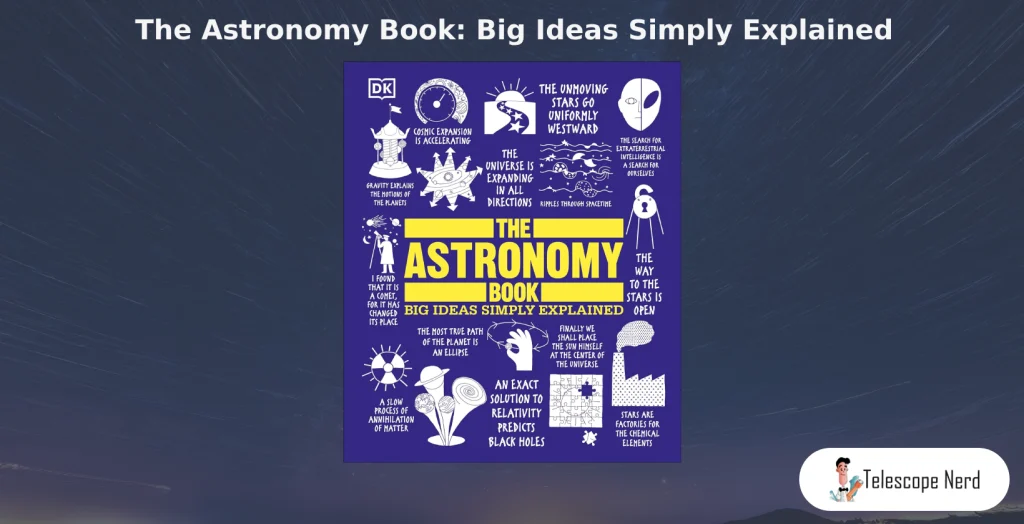
The Astronomy Book: Big Ideas Simply Explained is a comprehensive guide designed specifically for beginners delving into the vast field of astronomy. As part of DK’s renowned “Big Ideas” series, this book aims to demystify complex topics through simple, easy-to-understand language and visually appealing illustrations.
The book provides a broad overview of astronomy, covering key concepts, theories, and groundbreaking discoveries. It employs beautifully illustrated flowcharts, graphics, and jargon-free language to break down intricate ideas, making them accessible to readers with no prior knowledge in the field.
“The Astronomy Book” explores the evolution of astronomy, highlighting the contributions of significant figures such as Galileo, Newton, and Hubble. The book covers a wide array of topics, including the solar system, stars, galaxies, black holes, relativity, and string theory, making it suitable for beginners and those seeking a refresher.
The book’s unique approach lies in its ability to simplify abstract astronomical principles through visual explanations and straightforward language. This makes it an essential introductory guide that engages readers from diverse backgrounds.
“The Astronomy Book” offers practical guidance for budding astronomers. It provides advice on navigating the night sky, choosing telescopes, and identifying celestial objects. The book is replete with charts, maps, and stunning photography that serve as visual aids to enhance understanding.
The Astronomy Book has 336 pages. It measures 24.1 cm x 19.2 cm x 2.5 cm and features over 300 illustrations, photographs, and diagrams that elucidate complex astronomical concepts.
The book is divided into eight chapters, each section focuses on a different aspect of astronomy. The book includes timelines, glossaries, and “stop and think” sections to aid understanding and retention. With over 1,000 images, diagrams, and illustrations, the book visually explains complex processes and introduces readers to influential astronomers and their contributions.
9. The backyard astronomer’s guide by Terence Dickinson
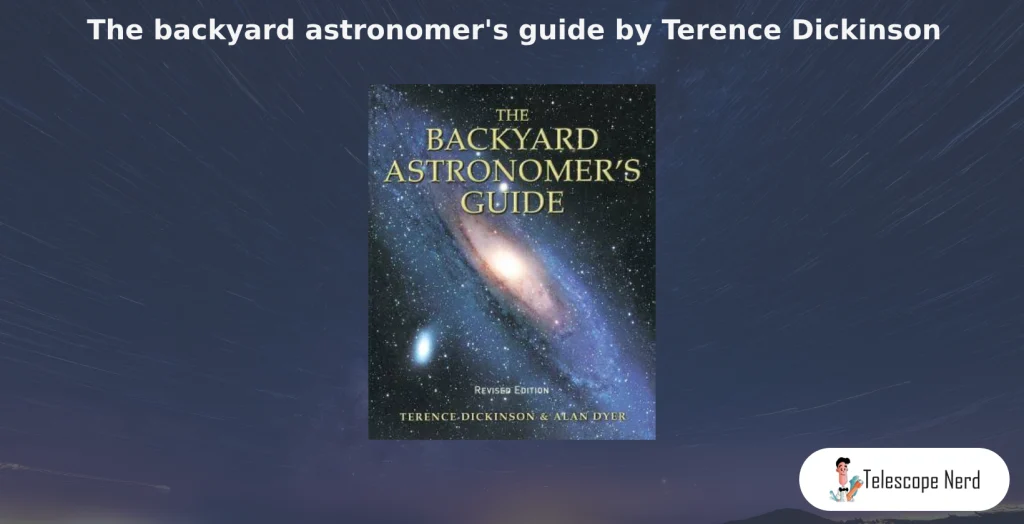
“The Backyard Astronomer’s Guide” by Terence Dickinson is a highly acclaimed book in the realm of astronomy, particularly for beginners venturing into the fascinating world of stargazing. This book is considered one of the best astronomy-related books for beginners due to its comprehensive coverage of various aspects of astronomy as a hobby.
The book provides valuable guidance on choosing the right equipment for stargazing, including telescopes, binoculars, eyepieces, and filters. It is a good resource for understanding the basics of space exploration and the different astronomical phenomena such as eclipses, comets, and meteor showers.
The book has detailed star charts and maps, which are incredibly useful for backyard stargazers. The book is beautifully illustrated with over 500 color photographs and diagrams, making it highly accessible and user-friendly for people of all ages and skill levels.
Terence Dickinson and Alan Dyer have ensured that the book stays up-to-date with the latest developments in amateur astronomy. The latest 4th edition was released in 2021. Latest edition a testament to their commitment to providing the most accurate and relevant information to readers.
The book is praised for its thorough research and clear, concise language, making complex astronomical concepts easy to understand. It serves as an excellent starting point for anyone interested in exploring the wonders of the universe from their own backyard.
10. Stargazing For Dummies by Steve Owens
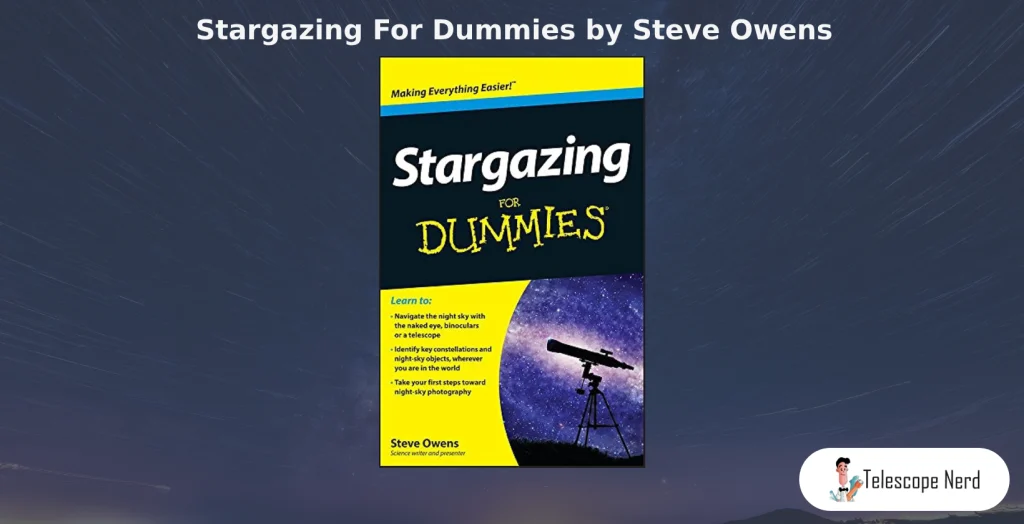
“Stargazing For Dummies” by Steve Owens is a highly recommended book for beginners looking to explore the fascinating world of astronomy. This book is designed to be a comprehensive guide for those new to stargazing, providing an easy-to-understand introduction to the hobby. It is considered one of the best astronomy books for beginners due to its user-friendly approach and detailed guidance.
The book introduces stargazing in a way that is neither overly technical nor boring. It covers essential topics for beginners, making it an ideal choice for those who are just starting their astronomy journey. The book discusses different methods of stargazing, including naked-eye observing, using binoculars, and using telescopes. It offers valuable advice on choosing the right equipment and how to use it effectively, making it a great resource for those looking to purchase their first telescope.
Stargazing For Dummies focuses on identifying and locating major constellations and prominent stars. It serves as a guide to constellations visible throughout the year, helping beginners to familiarize themselves with the night sky. The book provides tips and information for beginners to get started in astronomy and stargazing, including how to navigate celestial maps and plan stargazing sessions.
The book covers observing other celestial objects such as planets, nebulae, and galaxies. It provides guidance on observing these objects with the naked eye, binoculars, and telescopes. Steve Owens is a freelance science writer and presenter with a passion for making stargazing accessible and understandable for newcomers.
The content of the book is divided into four parts. The first part covers the basics of astronomy, including the solar system, stars, galaxies, and the universe as a whole. The second part focuses on choosing and using equipment, including telescopes and binoculars. The third part covers observing techniques, such as understanding celestial coordinates and using star charts. The final part is dedicated to exploring the night sky, including the moon, planets, asteroids, comets, and deep-sky objects like nebulae and galaxies.
11. Turn Left at Orion: Hundreds of Night Sky Objects to See in a Home Telescope – and How to Find Them by Dan M. Davis and Guy Consolmagno
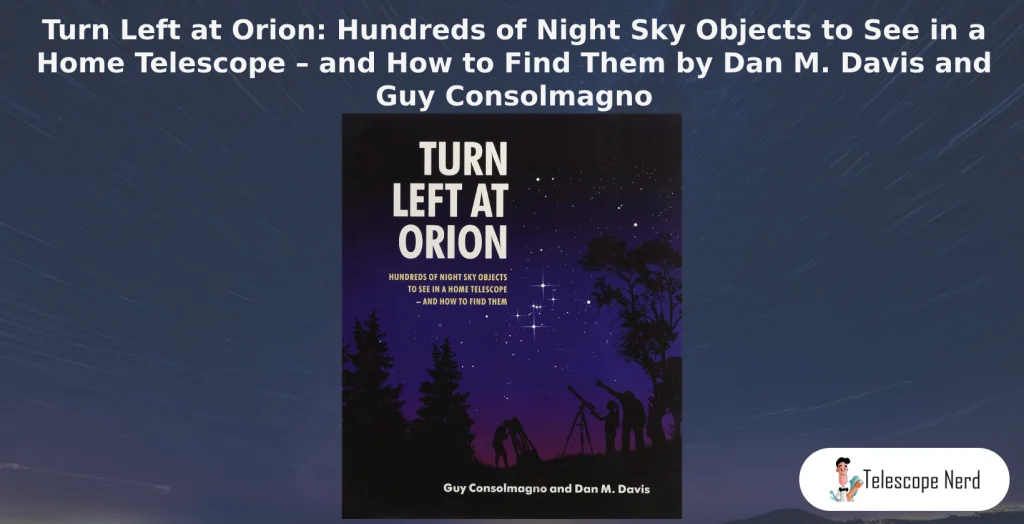
“Turn Left at Orion: Hundreds of Night Sky Objects to See in a Home Telescope – and How to Find Them” by Dan M. Davis and Guy Consolmagno is a comprehensive guidebook designed for beginning amateur astronomers. This book is tailored specifically for those starting out in backyard astronomy and with basic telescopic equipment. It assumes no prior knowledge of astronomy or telescope use, making it an ideal resource for beginners in stargazing.
The book provides detailed instructions to help use a home telescope and observe and explore the night sky. It covers hundreds of celestial objects, including planets, stars, galaxies, and nebulas. The instructions are clear and accessible, offering a user-friendly approach to astronomy that makes it easy for novices to use the book effectively.
Turn Left at Orion is divided into 12 chapters, the book covers various aspects of astronomy, such as understanding the solar system, exploring the Milky Way, and observing deep-sky objects. Each chapter includes clear descriptions of the objects, star charts, maps, and tips for optimal viewing conditions. The authors provide background information on the objects and interesting facts, enhancing the stargazing experience.
The book uses an object-by-object spread format, illustrating what the objects look like through different types of telescopes, including binoculars, small refractors, and Dobsonians. It includes detailed star maps, charts, and sketches to guide beginners in star-hopping and locating faint deep sky objects. The authors offer practical advice on using a telescope, setting it up, navigating the night sky, and overcoming common obstacles.
Multiple revised and updated editions of Turn Left at Orion have been published to ensure the information remains current. The writing style is clear, accessible, and full of practical tips, making it easy for novices to use the book effectively. The book offers a user-friendly approach to astronomy, making it accessible to newcomers and enhancing their stargazing experience.
12. The Stargazer’s Handbook by Giles Sparrow
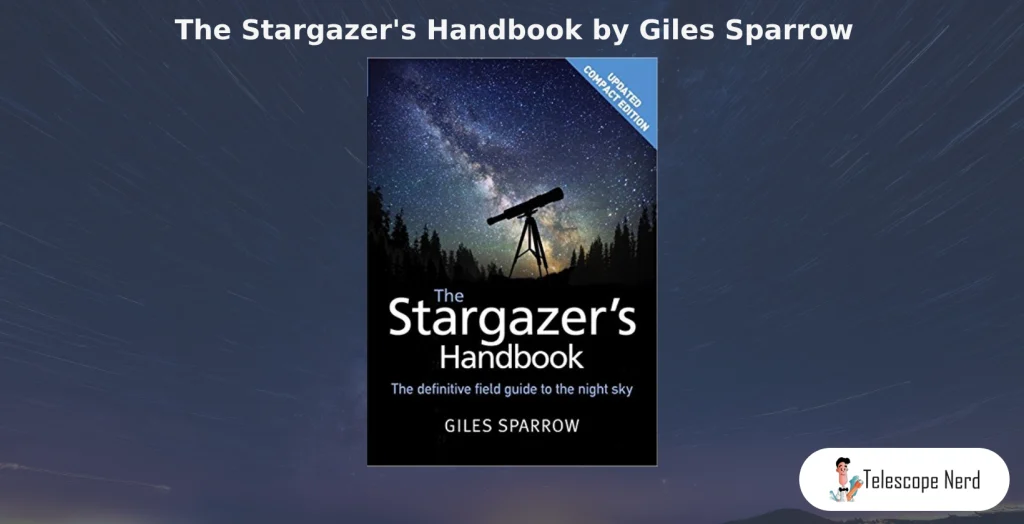
“The Stargazer’s Handbook” by Giles Sparrow is a highly recommended book for beginners in astronomy. This comprehensive guidebook covers a wide range of topics related to space and astronomical observations, making it one of the best astronomy books for those new to the field. The book is divided into four main sections, each focusing on different aspects of astronomy to provide a well-rounded understanding of the subject.
The first section of the book covers the fundamental concepts of astronomy, including our moon, planets, stars, galaxies, and the universe as a whole. It provides an accessible introduction to the solar system and the various celestial objects that can be observed in the night sky. This section is essential for beginners looking to build a strong foundation in astronomy.
The second section of The Stargazer’s Handbook provides guidance on navigating the night sky and identifying constellations. It includes detailed monthly guides and sky maps to help readers locate constellations and other night sky sights based on the time of year. This section provides tips on observing celestial objects using binoculars and telescopes, making it an excellent resource for backyard astronomers of all skill levels.
The third section of the book goes into more advanced topics such as black holes, supernovae, and the search for extraterrestrial life. It provides a deeper understanding of the wonders of space and the complex processes that govern the universe. This section is perfect for those looking to expand their knowledge of astronomy beyond the basics.
The fourth section of The Stargazer’s Handbook offers practical advice on choosing the right equipment, understanding astronomical maps, and planning observing sessions. It provides valuable insights into the best practices for observing the night sky and making the most of your astronomical observations. This section is an excellent resource for beginners looking to get started with stargazing.
Sparrow uses clear and concise language to make complex astronomy concepts accessible to beginners. The book contains over 400 high-quality astronomical images and illustrations, which aid in identifying and learning about celestial objects. These visual aids are an excellent resource for those looking to develop a deeper appreciation of the night sky and the vast expanse of space.
Reviews of “The Stargazer’s Handbook” praise the book as well-written, educational, and containing excellent visual aids and reference materials for backyard astronomers of all skill levels. It is considered one of the best astronomy books for beginners due to its comprehensive coverage of the subject and its accessibility to those new to the field.
13. Exploring the Night Sky: The Equinox Astronomy Guide for Beginners by Terence Dickinson
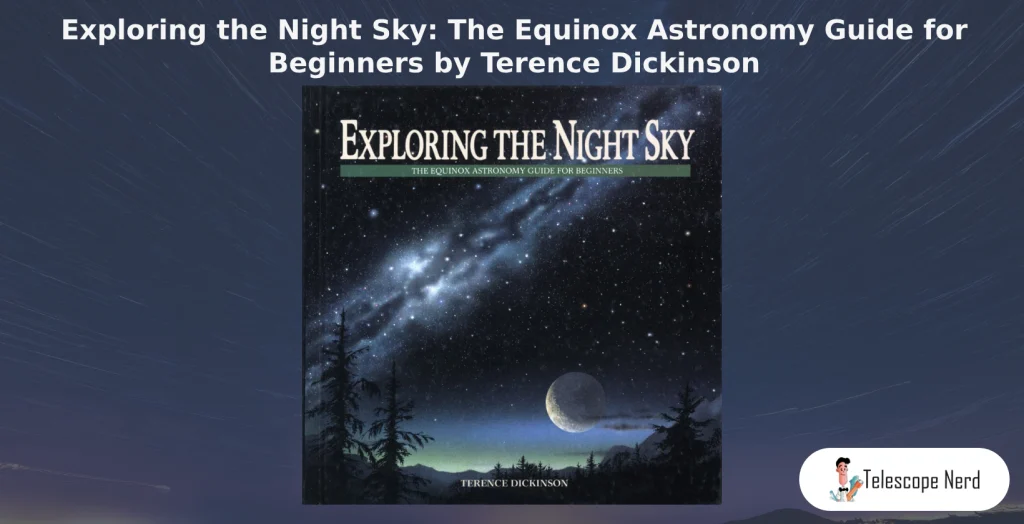
“Exploring the Night Sky: The Equinox Astronomy Guide for Beginners” by Terence Dickinson is a highly acclaimed book and one of the best introductory astronomy guides available for beginners. This book is designed to be an excellent introduction to astronomy, making it accessible and easy to understand for readers of any age or background knowledge level. It is considered a top-rated resource for learning the basics of astronomy and stargazing in a clear, concise, and user-friendly manner.
The book covers a wide range of topics related to astronomy, making it a comprehensive guide for those interested in space and stargazing. It goes beyond just recognizing the Big Dipper and Little Dipper constellations, delving into exploring the night sky, the moon, the life cycle of stars, and how to best observe celestial objects and phenomena. The guide includes practical advice on how to get started with amateur astronomy, such as choosing the right telescopes and binoculars for stargazing.
Exploring the Night Sky makes complex astronomical concepts easy to understand. This is achieved through clear writing and helpful illustrations, including stunning photographs, diagrams, and illustrations. The book is divided into 12 chapters, covering the basics of astronomy, stargazing, understanding the solar system, its planets, exploring stars, galaxies, and the universe. It covers observing the moon, the sun, and celestial events.
Terence Dickinson shares his expertise and passion for astronomy throughout the book. He takes readers on a journey through the night sky, exploring the wonders of space and the universe. The book includes a glossary of related terms, a star chart, and a moon map, making it a valuable resource for anyone interested in astronomy.
14. Celestial Sampler: 60 Small-Scope Tours for Starlit Nights by Richard Tresch Fienberg and Sue French
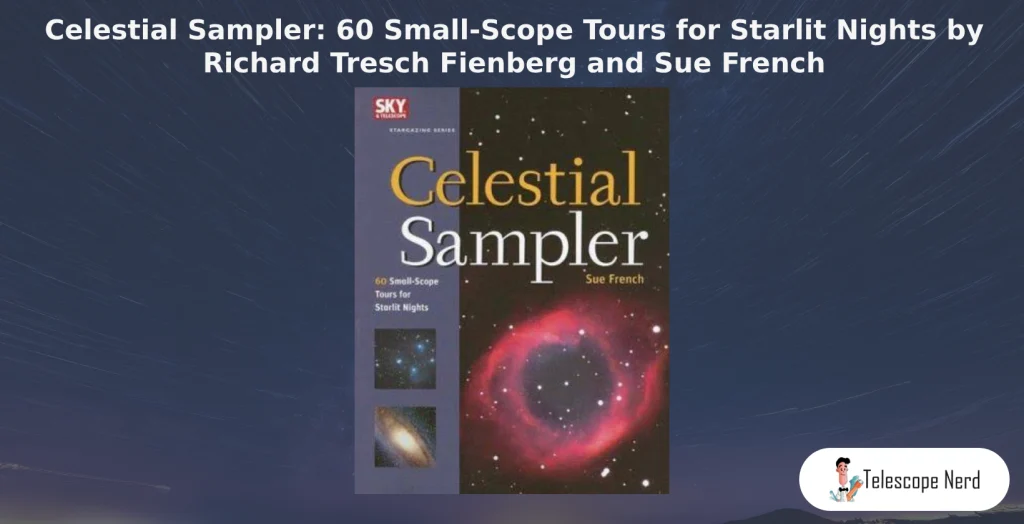
“Celestial Sampler: 60 Small-Scope Tours for Starlit Nights” is an astronomy book designed specifically for beginners and amateur stargazers. Celestial Sampler aims to make astronomy accessible to those new to the field. The book is particularly beneficial for individuals with small aperture telescopes or binoculars, serving as an excellent resource for those with limited equipment.
The content of the book is structured around 60 guided tours of the night sky, each focusing on a specific region or object. These tours are tailored for small telescopes or binoculars, making it an ideal resource for beginners in astronomy. The celestial objects included in the tours range from stars and star clusters to nebulae and galaxies. The tours are organized by season, making it easy for readers to plan their stargazing sessions throughout the year.
The target audience for “Celestial Sampler” is beginners and amateur astronomers who are just starting their stargazing journey. The book provides a wealth of information, making it an invaluable resource for anyone interested in astronomy and stargazing. It is designed to help users with small telescopes or binoculars explore the night sky and appreciate the wonders of the universe from the comfort of their own backyard.
Each tour in the book includes detailed descriptions of celestial objects, their locations, and observing tips. The book includes star charts and maps to help readers navigate the night sky. This makes it a good astronomy book for beginners, as it provides clear instructions and accessible descriptions.
The content of “Celestial Sampler” is organized into six sections: The Brightest Stars, Double and Multiple Stars, Star Clusters, Nebulae, Galaxies, and Special Objects. Each section covers a different aspect of the sky, featuring a variety of stars, star clusters, nebulae, and galaxies. This organization makes it one of the best astronomy books for beginners, as it provides a comprehensive introduction to the field.
Sue French writes about objects that provide both easy and challenging targets. The authors’ passion for astronomy shines through in their clear instructions and accessible descriptions. This makes “Celestial Sampler” not just a good astronomy book, but one of the best books for beginners interested in stargazing.
15. Find the Constellations by H. A. Rey
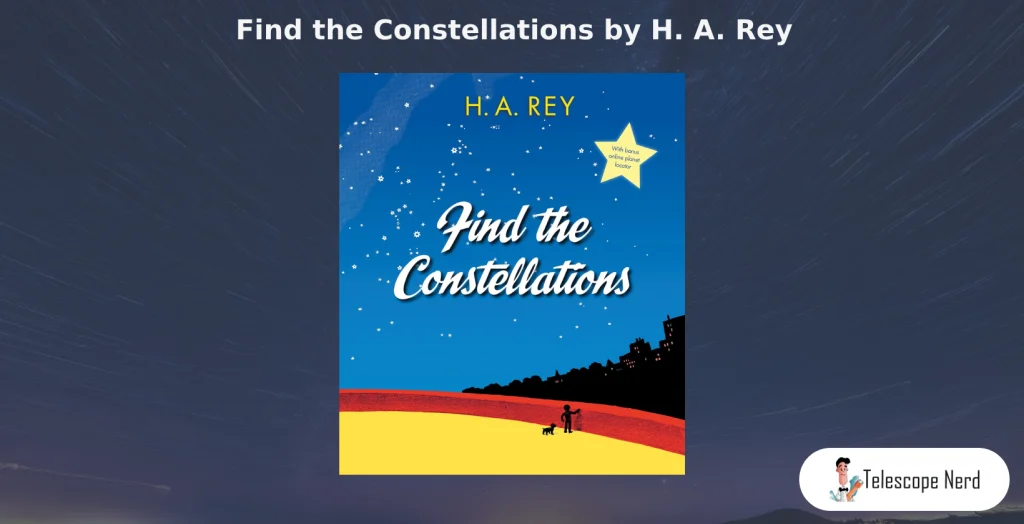
“Find the Constellations” by H.A. Rey is a highly recommended book for beginners interested in stargazing and learning about constellations. This book serves as a comprehensive guide to locating and identifying constellations in the northern hemisphere, making it an excellent resource for those just starting their astronomy journey.
The book contains detailed star charts that are easy to follow, even for those with no prior knowledge of astronomy. It provides valuable information about the seasons and the movement of celestial objects in the sky, helping beginners understand the ever-changing night sky.
Find the Constellations is filled with clear and accurate depictions of constellations, which are essential for beginners trying to identify these patterns in the sky. H.A. Rey is well-known for his illustrations, having created the popular Curious George children’s book series.
The book covers a wide range of constellations, including well-known ones like Orion, Cassiopeia, and Ursa Major, as well as lesser-known constellations such as Cygnus and Lyra. It employs a unique “star-hopping” method, which guides readers to find a constellation by starting with a familiar pattern and then “hopping” to a nearby star or group of stars. This approach makes navigating the night sky much more manageable for beginners.
Find the Constellations offers fascinating insights into the mythology and history behind each constellation. These engaging stories and facts make the learning process more enjoyable and enriching.
Find the Constellations was first published in 1954. Book has stood the test of time and is considered a classic in introductory astronomy literature.
16. Discover the Stars: Starwatching Using the Naked Eye, Binoculars, or a Telescope
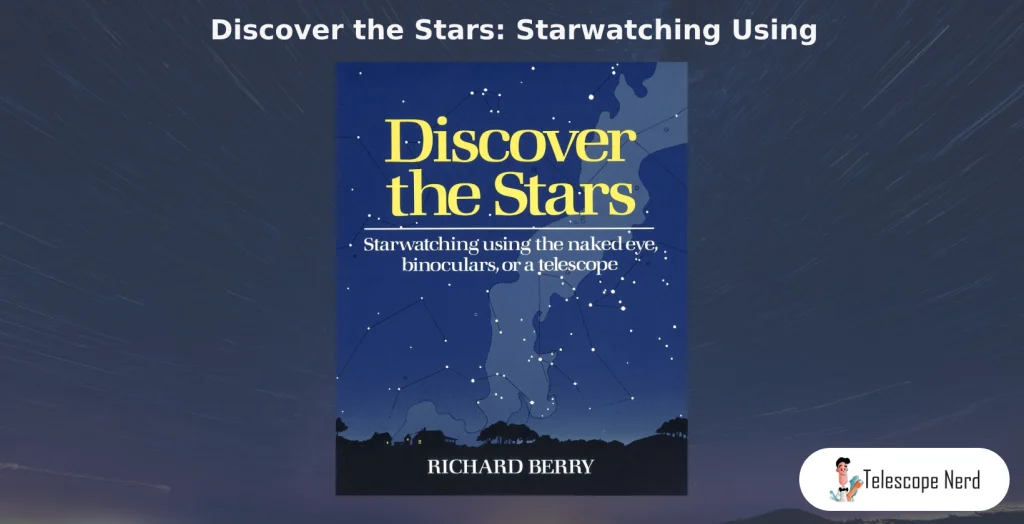
” Discover the Stars: Starwatching Using the Naked Eye, Binoculars, or a Telescope” is a beginner-friendly guidebook designed to introduce novice stargazers to the captivating world of astronomy. This book is a comprehensive resource that equips beginners with the necessary knowledge and skills to embark on their stargazing journey.
The book primarily focuses on teaching readers how to locate and observe various celestial objects, with a particular emphasis on stars and constellations. It provides detailed star charts and maps that aid in identifying and understanding the patterns of constellations. This visual guidance is supplemented with practical advice on using tools such as telescopes and binoculars, making the experience more interactive and engaging for beginners.
“Discover the Stars” has a detailed explanation of the “star hopping” technique. This method involves using prominent stars and constellations as landmarks to navigate the night sky and locate other celestial objects. This technique is particularly useful for beginners who may initially find it challenging to locate specific stars or constellations.
The book offers valuable advice on choosing the right observation sites and equipment for stargazing. It emphasizes the importance of finding a dark location, away from city lights and light pollution, to get a clear view of the stars. The book suggests using binoculars for a wider field of view and recommends red light flashlights to preserve night vision while navigating in the dark.
17. See It with a Small Telescope: 101 Cosmic Wonders Including Planets, Moons, Comets, Galaxies, Nebulae, Star Clusters and More by Will Kalif
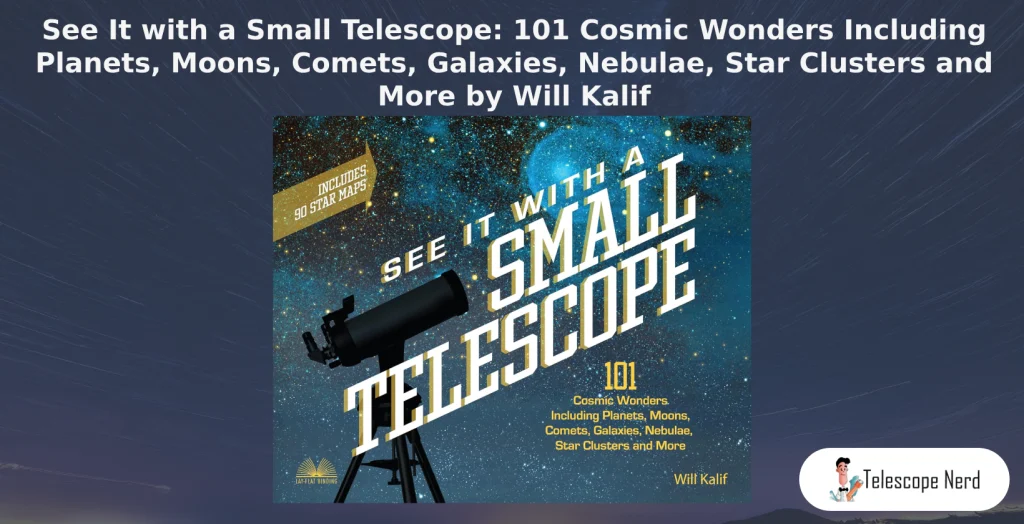
“See It with a Small Telescope: 101 Cosmic Wonders Including Planets, Moons, Comets, Galaxies, Nebulae, Star Clusters and More” by Will Kalif is an exceptional astronomy book designed for beginners and amateur stargazers. This comprehensive guide aims to make astronomy accessible and enjoyable, even for those using small telescopes.
The purpose of the book is to demystify the process of discovering celestial objects and to encourage readers to embark on a journey of cosmic exploration right from their backyard. It is considered one of the best books for beginners due to its practical approach and easy-to-use format.
The content of the “See It with a Small Telescope” is rich and varied. It provides detailed information on 101 celestial objects that can be observed with a small telescope. These objects range from planets, moons, comets, galaxies, nebulae, to star clusters. The book covers notable celestial bodies such as the Andromeda Galaxy, the Orion Nebula, and the Pleiades star cluster, among others.
Kalif’s book offers hands-on tips, practical tricks, and advice to help readers maximize the use of their small telescopes. It provides guidance on the best times and conditions for observing celestial objects, making it an ideal resource for those new to stargazing.
Will Kalif shares his passion and expertise in astronomy throughout the book. He provides stunning images and practical advice to enhance the stargazing experience. The book focuses on telescopes with an aperture of 60-102mm (2.4-4 inches), making it a perfect guide for those using small telescopes.
